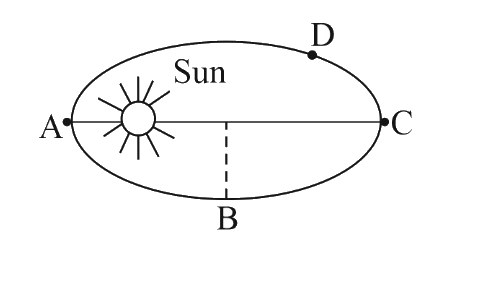A planet is revolving round the sun is elliptical orbit. Velocity at perigee position ( nearest) is v1 and at apogee position ( farthest) is v2. Both these velocities are perpendicular to the line joining centre of sun and planet. r1 is the minimum distance and r2 the maximum distance.
At apogee position suppose speed of planet is slightly decreased from v2, then what will happen to minimum distance r1 and maximum distance r2 in the subsequent motion.
r1 and r2 both will decrease
r1 and r2 both will increase
r2 will remain as it is while r1 will increase
r2 will remain as it is while r1 will decrease
The correct Answer is:D
To solve the problem, we need to analyze the motion of a planet in an elliptical orbit around the Sun, particularly focusing on the effects of a decrease in velocity at the apogee position.
1. Understanding the Orbit:
- A planet in an elliptical orbit has two key positions: perigee (closest point to the Sun) and apogee (farthest point from the Sun).
- Let r1 be the distance at perigee and r2 be the distance at apogee.
2. Initial Conditions:
- The planet has velocities v1 at perigee and v2 at apogee, both perpendicular to the line joining the Sun and the planet.
- According to Kepler's laws, the area swept out by the line joining the planet and the Sun is constant.
3. Effect of Decreasing Velocity at Apogee:
- When the speed of the planet at apogee is slightly decreased from v2, the total mechanical energy of the planet in its orbit decreases.
- This decrease in energy causes the orbit to become more elliptical.
4. Conservation of Angular Momentum:
- The angular momentum of the planet must be conserved. Since the velocity at apogee is decreased, the distance r2 must remain constant to conserve angular momentum.
- Therefore, r2 remains unchanged.
5. Change in Perigee Distance:
- As the orbit becomes more elliptical, the minimum distance r1 will decrease. This is because the planet will move closer to the Sun at perigee after the decrease in velocity at apogee.
- Thus, r1 decreases while r2 remains constant.
Conclusion:
- After the decrease in speed at apogee, the minimum distance r1 will decrease, while the maximum distance r2 will remain unchanged.
- A planet in an elliptical orbit has two key positions: perigee (closest point to the Sun) and apogee (farthest point from the Sun).
- Let r1 be the distance at perigee and r2 be the distance at apogee.
- The planet has velocities v1 at perigee and v2 at apogee, both perpendicular to the line joining the Sun and the planet.
- According to Kepler's laws, the area swept out by the line joining the planet and the Sun is constant.
- When the speed of the planet at apogee is slightly decreased from v2, the total mechanical energy of the planet in its orbit decreases.
- This decrease in energy causes the orbit to become more elliptical.
- The angular momentum of the planet must be conserved. Since the velocity at apogee is decreased, the distance r2 must remain constant to conserve angular momentum.
- Therefore, r2 remains unchanged.
- As the orbit becomes more elliptical, the minimum distance r1 will decrease. This is because the planet will move closer to the Sun at perigee after the decrease in velocity at apogee.
- Thus, r1 decreases while r2 remains constant.
- After the decrease in speed at apogee, the minimum distance r1 will decrease, while the maximum distance r2 will remain unchanged.
Topper's Solved these Questions
Similar Questions
A planet is revolving round the sun is elliptical orbit. Velocity at perigee position ( nearest) is v1 and at apogee position ( farthest) is v2. Both these velocities are perpendicular to the line joining centre of sun and planet. r1 is the minimum distance and r2 the maximum distance.
When the planet is at perigee position, it wants to revolve in a circular orbit by itselff. For this, value of G
View SolutionA planet is revolving around the sun as shown in elliptical path. The correct option is

View Solution
Knowledge Check
If a planet revolves around the sun in a circular orbit of radius a with a speed of revolution T, then (K being a positive constant
AT=Ka2/3BT=Ka3/2CT=Ka2DT=Ka3A planet revolves around the sun in an elliptical orbit. If vp and va are the velocities of the planet at the perigee and apogee respectively, then the eccentricity of the elliptical orbit is given by :
AvpvaBva−vpva+vpCvp+vavp−vaDvp−vavp+va
A planet is revolving round the sun in an elliptical orbit as shown in figure. Select correct alternative(s)
View SolutionA planet is moving round the sun in an elliptical orbit as shows. As the planet moves from A to B

View SolutionFor a planet revolving around Sun in an elliptical orbit, to obtain its velocity at any point we have to apply
View SolutionA planet is revolving round the sun in an elliptical orbit, If v is the velocity of the planet when its position vector from the sun is r, then areal velocity of the planet is
View SolutionA planet revolves around the sun in an elliptical . The linear speed of the planet will be maximum at

View SolutionA planet is revolving around the Sun in an elliptical orbit. Its closest distance from the Sun is r and farthest distance is R. If the orbital velocity of the planet closest to the Sun is v, then what is the velocity at the farthest point?
View Solution
